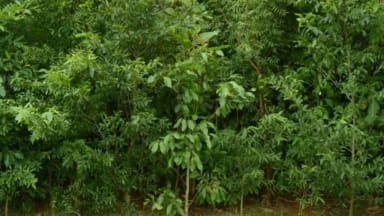
A partnership led by The Tree Council, Defra, and Natural England, with Kent County Council, Chichester District Council, Cornwall Council, Norfolk County Council, and Shropshire Council seeks to identify more cost-effective methods for local authorities to increase tree canopy cover in England.
The Trees Outside Woodland project has been trialling the Miyawaki method, developed by Japanese botanist Dr Akira Miyawaki. First used in Japan in the 1970’s the Miyawaki method has proved to have significant benefits over more traditional forestry methods – particularly effective in an urban environment.
Miyawaki’s tree planting technique, involves high density planting in specially prepared soil – mimicking natural reforestation principles. Hence using native trees and replicating natural forest regeneration processes. The tree seedlings are planted at very high densities to replicate the regeneration process that naturally occurs in a forest when a clearing in the canopy opens up due to a larger tree falling. The saplings grow very fast to compete for the light and then natural selection will favour the fastest growing individuals and act to thin out the trees. The result is a densely packed pioneer forest that reportedly grows in 20-30 years instead of taking 150-200 years.
Jon Stokes, Director of Trees, Science & Research at The Tree Council said: “In the first three years after planting, the survival rates of young trees in urban areas can be very low. We therefore set out to test alternative planting methods to see if we could identify practices which improved survival rates and which made trees less vulnerable to issues such as vandalism. Solving this puzzle is key to helping local authorities deliver successful and cost-effective tree planting, unlocking all the benefits that urban trees have to offer. One of the methods which we trialled was the Miyawaki method”.
A total of 16 different trial sites were planted as part of the Trees Outside Woodland project, across four local authorities. Planting included a variety of native tree and shrub species, planted densely at 3-5 trees per m2 in prepared and enhanced soil – alongside a control of traditional planting methods. The trial sites are located in areas of high air pollution, below average tree cover and/or high levels of deprivation – hence where trees could make a real difference.
Analysis in 2024 at one of the trial sites reported a 99% survival rate, with the trees resembling a dense thicket, and some trees reaching 15 ft. The control sites also showed positive survival rates of 82%, but visibly slower growth resulting in shorter trees. In terms of costs, the average cost of the Miyawaki method was £9.66 per survived tree, against £50.32 for standard planting methods. This reflects the greater survival rates across the trials of the Miyawaki methods, with a 79% survival rate compared to 47% for the standard planting methods. The trials will be monitored until September 2025, after which further research will be conducted to establish the long-term performance of the urban Miyawaki forests.
Rob Thomas, Kent County Council’s Cabinet Member for Environment, said: “I am thrilled that KCC is among the first to trial an adapted version of the Miyawaki tree planting method, and that it has been such a success for Kent. The trees that have been planted by the Miyawaki method have proven to be fast-growing, resilient to the stressors of urban areas and are boosting our local ecosystem.”
Natural England Chair Tony Juniper said: “This study is looking for answers and the results will help inform future decision making to increase successful and reliable young tree establishment and protect newly planted trees so that they grow and thrive in local areas and provide benefits for generations to come.”

